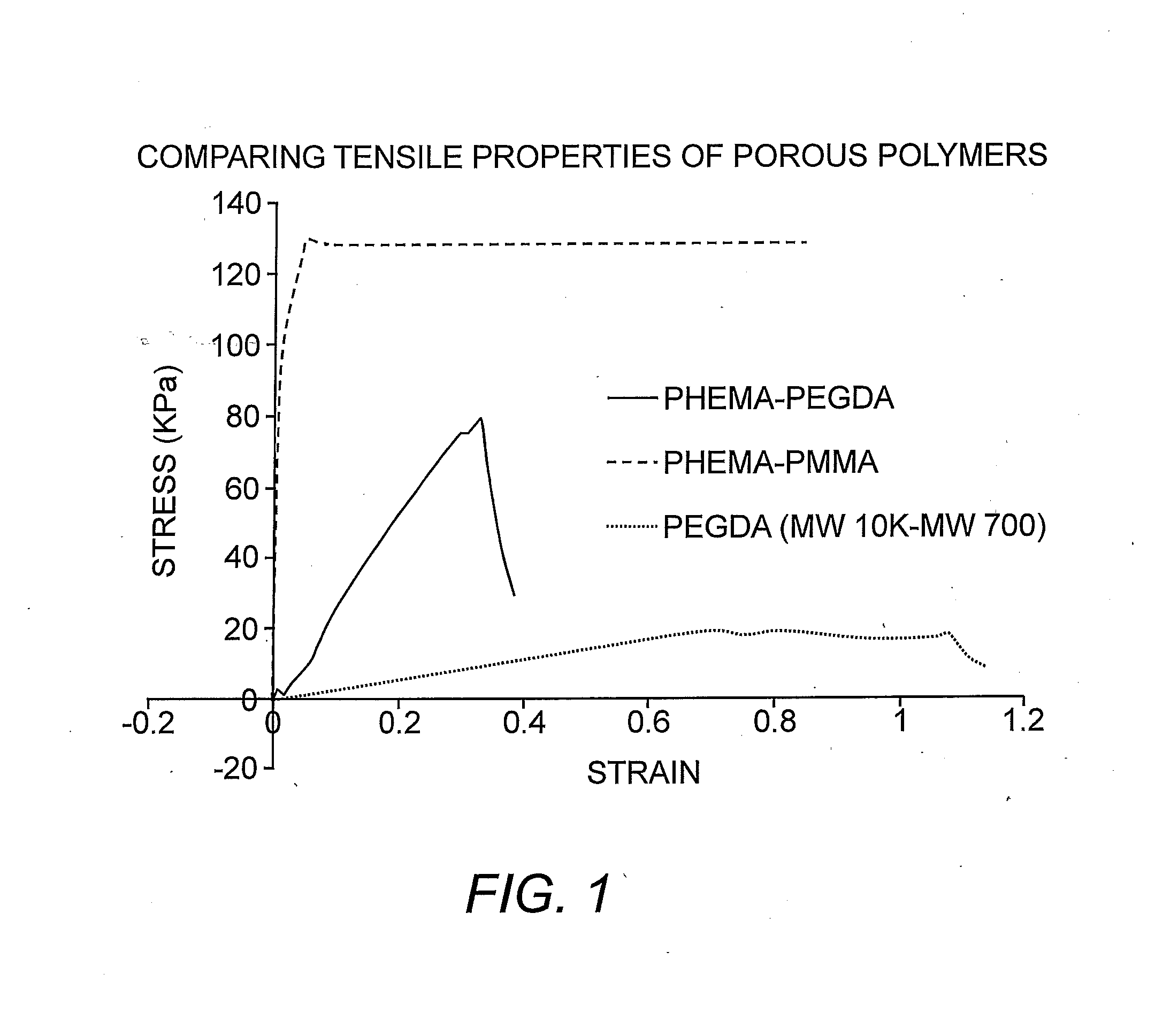Suturable hybrid superporous hydrogel keratoprosthesis for cornea
- Summary
- Abstract
- Description
- Claims
- Application Information
AI Technical Summary
Benefits of technology
Problems solved by technology
Method used
Image
Examples
example 1
Materials & Methods
[0040]Cell Culture.
[0041]Two cell types, stem cells and committed cells, were analyzed. Human mesenchymal stem cells (MSCs) were maintained in Gibco's α-Minimal Essential Medium (with L-glutamine, without ribonucleosides, without deoxyribonucleosides) containing 15% fetal bovine serum (FBS), 1% L-glutamine, and 1% antibiotics. The HT-1080 human fibrosarcoma cell line was purchased from ATCC (Manassas, Va.). Fibroblasts were bathed in Dulbecco's Modified Eagle's Medium (DMEM) supplemented with 10% fetal bovine serum (FBS) and 1% antibiotics / antimycotics. Media was changed every two to three days to remove wastes and provide fresh nutrition. Cells were maintained at 37° C. in the presence of 5% CO2 and 95% air. Cells were plated at a density of 3×103 cells / cm2 in tissue culture flasks until a 75-80% confluent monolayer was formed. Cells were passaged by incubating for 5 minutes with 0.25 mg / mL trypsin and replating at the above density. All cells used in the experim...
example 2
[0062]Since collagen begins to gel quickly after pH neutralization, immediate upload into the SPH was necessary to facilitate uniform distribution throughout the SPH. Since the SPH fabrication method created interconnected macrosized pores, swelling occurred in less than 1 minute. Soaking the SPH in a collagen solution allowed natural materials to enter the pores easily and rapidly via capillary action. Thus, wherein preseeding with cells is desired, cells can be suspended in the collagen solution just prior to uptake. Swelling was determined by the degree and size of interconnected pores. SEM analysis of pore structure in three SPHs created with 100, 200, and 300 mg of sodium bicarbonate revealed two types of pores: larger pores which appeared similar in size and shape in each of the SPHs and smaller pores, which formed the interconnection pathways. It was apparent that increasing the amount of sodium bicarbonate resulted in an increased number of interconnection pore...
example 3
Adhesion Staining
[0066]In preseeded scaffolds, it was observed that collagen encouraged fibroblast spreading in 3-D and formation of stress fibers. Scaffolds without collagen housed clumped, round cells that were incapable of attaching to the scaffold. PEGDA is intrinsically resistant to adhesion. Thus, a lack of ECM cell binding sites in non-collagenous scaffolds was presumed to be responsible for the round morphology. After 48 hours, scaffolds without collagen were completely acellular. Having nothing to attach to, cells tended to migrate out of the scaffold and attach to the tissue culture plate below.
[0067]In contrast, collagen loaded scaffolds showed cell retention within the scaffold and few if any cells attached to the plate below. Collagen within the hydrogel pores greatly enhanced cell spreading and retention in a 3-D manner. The microfilament stress fibers were clearly observed, indicating that cell adhesion was mediated by integrin binding sites available in collagen, lea...
PUM
| Property | Measurement | Unit |
|---|---|---|
| Temperature | aaaaa | aaaaa |
| Diameter | aaaaa | aaaaa |
| Dimensionless property | aaaaa | aaaaa |
Abstract
Description
Claims
Application Information
 Login to View More
Login to View More - R&D
- Intellectual Property
- Life Sciences
- Materials
- Tech Scout
- Unparalleled Data Quality
- Higher Quality Content
- 60% Fewer Hallucinations
Browse by: Latest US Patents, China's latest patents, Technical Efficacy Thesaurus, Application Domain, Technology Topic, Popular Technical Reports.
© 2025 PatSnap. All rights reserved.Legal|Privacy policy|Modern Slavery Act Transparency Statement|Sitemap|About US| Contact US: help@patsnap.com


